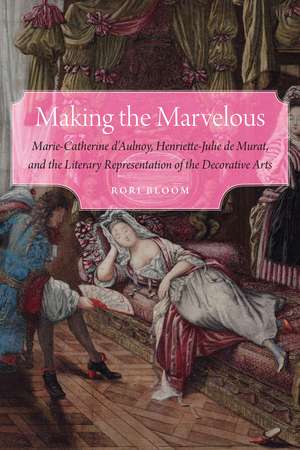Making the Marvelous: Marie-Catherine d’Aulnoy, Henriette-Julie de Murat, and the Literary Representation of the Decorative Arts: Early Modern Cultural Studies
Autor Rori Bloomen Limba Engleză Hardback – 31 mai 2022
Preț: 507.56 lei
Nou
Puncte Express: 761
Preț estimativ în valută:
97.13€ • 101.03$ • 80.19£
97.13€ • 101.03$ • 80.19£
Carte tipărită la comandă
Livrare economică 14-28 aprilie
Preluare comenzi: 021 569.72.76
Specificații
ISBN-13: 9781496222671
ISBN-10: 1496222679
Pagini: 250
Ilustrații: 1 appendix, index
Dimensiuni: 152 x 229 x 24 mm
Greutate: 0.54 kg
Editura: Nebraska
Colecția University of Nebraska Press
Seria Early Modern Cultural Studies
Locul publicării:United States
ISBN-10: 1496222679
Pagini: 250
Ilustrații: 1 appendix, index
Dimensiuni: 152 x 229 x 24 mm
Greutate: 0.54 kg
Editura: Nebraska
Colecția University of Nebraska Press
Seria Early Modern Cultural Studies
Locul publicării:United States
Notă biografică
Rori Bloom is an associate professor of French at the University of Florida. She is the author of Man of Quality, Man of Letters: The Abbé Prévost between Novel and Newspaper.
Cuprins
Acknowledgments
Author’s Note
Introduction
1. Fairy Tale as Palace Tour: Description and Setting
2. Stories That Illustrate Themselves: Description and Painting
3. Essential Accessories: The Object as Objet d’art
4. D’Aulnoy’s Travels in Spain: Description and Demystification
5. Disenchanted Decors in Murat: Voyage de campagne and Les Lutins du château de Kernosy
Conclusion
Appendix
Notes
Bibliography
Index
Author’s Note
Introduction
1. Fairy Tale as Palace Tour: Description and Setting
2. Stories That Illustrate Themselves: Description and Painting
3. Essential Accessories: The Object as Objet d’art
4. D’Aulnoy’s Travels in Spain: Description and Demystification
5. Disenchanted Decors in Murat: Voyage de campagne and Les Lutins du château de Kernosy
Conclusion
Appendix
Notes
Bibliography
Index
Recenzii
"Making the Marvelous imparts a highly original premise that yields compelling and unexpected results. Not only does this study shed new light on the late seventeenth-century fairy-tale movement by presenting an alternative theoretical framework for understanding how the descriptive style functions in the works of two of the genre's most important practitioners, it also exposes the complex ideological stakes of ornamental writing, both in general and in the particular sociohistorical context of late seventeenth-century France. . . . This book is a must-read for fairy-tale scholars, literary historians, art historians, and anyone interested in learning more about the intersections of literature and the decorative arts at the dawn of the French Enlightenment."—Allison Stedman, Eighteenth-Century Fiction
“Clearly argued, carefully crafted, and finely detailed, this book is a real gem. It offers a fresh look at the works of d’Aulnoy and Murat by highlighting their embrace of ornament and artful materiality and brilliantly demonstrates the modernity and sophistication of their writing.”—Volker Schröder, associate professor of French at Princeton University
“Rori Bloom’s fascinating new approach to reading d’Aulnoy’s and Murat’s fiction focuses on descriptions and shows that the craftsmanship in the decorative arts informs the marvelous and functions as an analogy between the visual arts and the authors’ own verbal craft.”—Charlotte Trinquet du Lys, associate professor of French and affiliate professor of women and gender studies and medieval and Renaissance studies at the University of Central Florida
“Compelling. . . . By focusing on the artistic processes at work (as opposed to simply the finished product) and how d’Aulnoy and Murat shape their fairy tales as art—as fashionable accessories—Making the Marvelous sheds new light on the early modern fairy tales penned by women.”—Anne E. Duggan, author of Salonnières, Furies, and Fairies: The Politics of Gender and Cultural Change in Absolutist France
Descriere
Rori Bloom demonstrates that Marie-Catherine d’Aulnoy (1652–1705) and Henriette-Julie de Murat (1670–1716) changed the stakes of the fairy tale: instead of inviting their readers to marvel at the magic that changes rags to riches, they enjoined them to acknowledge the skill that transforms raw materials into beautifully made works of art.
















